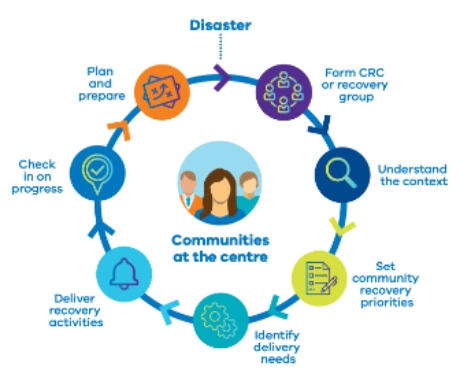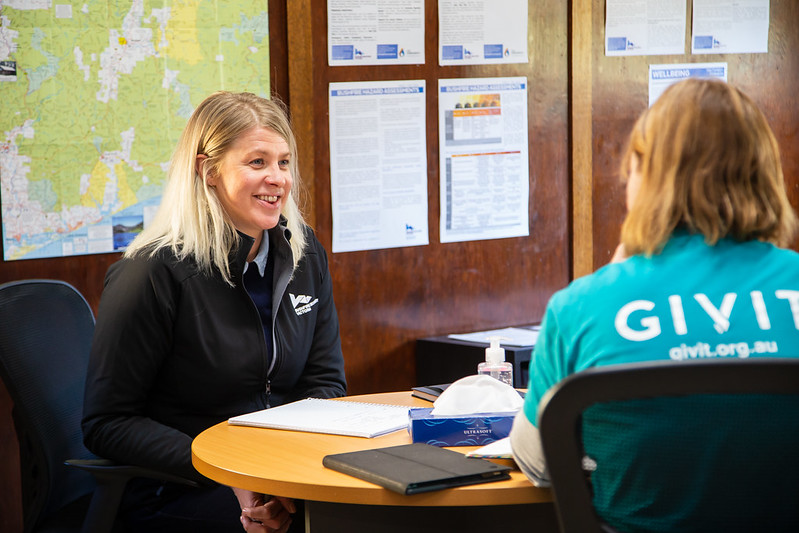How to deliver on (and realize the benefits of!) digital transformation like Bushfire Recovery Victoria
Meet the industry's next trailblazer.
Bushfire Recovery Victoria (BRV) was established to work directly with Victorian communities affected by the devastating 2019-20 Eastern Victorian bushfires that burned over the course of many months across the eastern seaboard and other parts of Australia simultaneously.
In other words, “we work with communities and recovery agencies to develop collective understanding of people’s needs in the aftermath of natural disasters, and coordinate services across government and non-government partnerships accordingly so that Victoria can build back better,” said Eric Savoie, Director, Planning and Coordination, BRV. “Research (and experience) shows that connected people and places strengthen resilience and improve disaster recovery outcomes, which is why we work to bring communities and recovery agencies together to design solutions that help people recover.”
Learn more about Bushfire Recovery Victoria’s digital-first vision
It’s a community-led approach to recovery that is shared by the people who are at the heart of BRV’s mission. Every community is as unique as the people living in it, meaning processes have to empower locals to:
- voice the ways they experienced the trauma
- participate in the recovery effort
- assume an active role in making decisions
- take a leadership role in their long-term recovery.
Unlike emergency response efforts, which tend to be a more controlled focus on protecting and securing the safety of a community, BRV’s recovery coordination looks at understanding the impacts and consequences of a given event. BRV uses those insights to create locally led, locally-delivered services. It’s a new way of thinking — which shouldn’t be too surprising when the context is considered.
“We were established as an agency a few months before COVID-19 forced the world into lockdown,” Savoie said. "So, we found ourselves having to figure out a way to activate people and communities, as a new agency, in a new working environment."
And they did it. Here’s how.
Step 1: start with the vision.

Step 2: walk through the strategy.
Once community recovery committees were in place, BRV’s next step was to determine how to best support them as they began engaging the community, determining recovery priorities, and connecting people to service organisations – a strategy that was dependent on both external and internal considerations.
External considerations:The BRV team had to think through trust. In any town or city, there tends to be several pre-existing local service providers and community groups who have been proud to be a part of celebrations, milestones, and holidays for many years, and as a result have transcended titles like ‘restaurant’ or ‘local bakery’ to become a cornerstone of the community.
“Working together with local councils and community recovery committees, we were able to extend our reach through these local organisations to develop trusted relationships and meet people where they felt most comfortable engaging. Without this strategy, it would have taken us a long, long time to establish that same trusted relationships, which is a luxury we don’t always have in disaster recovery,” said Savoie. “Working through the trusted relationships that already exist means we can have a much greater impact greater in those early moments of helping and catching someone.”
Especially those who are reaching out for the very first time. In its Annual Climate Statement 2019, the Bureau of Meteorology found that the bushfires of the past season were the largest of any Australian fire season in recorded history. Victoria alone saw 1.5 million hectares of Country burnt, affecting 736 properties, destroying 313 homes – and an area containing more than 1,000 registered Aboriginal heritage places.[1] The larger the disaster, the greater the number of people impacted. For some this may be the first time they required some level of assistance in overcoming a challenge in their lives.
“We had considered that it may be the first time someone has had to seek government support. That can be confronting and daunting on top of what is already a very stressful situation,” said Savoie. “Our communications team has worked really hard to think through how best to communicate in a trauma-informed way, reach a diverse range of customers, and be able to meet their individual needs, no matter which stage they were in on their personal recovery journey.”
Internal considerations:Trust and communications were equally important to BRV’s strategy internally, across tiers of government. Government at all levels has preexisting relationships, programs, and processes that aren’t necessarily joined up through a coordinated intake.
“If you think about community development, it’s all about building local capacity and leveraging community knowledge,” said Savoie. “If we were going to build confidence in this new style of working with the public, we needed to educate our ecosystem on what community-led practice is, and why it was so important to enable it digitally. We had to learn how to shift our thinking to focus more on customer-centricity, and then organise partnerships correspondingly.”
The BRV team started outlining what communications and collaboration would look like so that the internal support system mirrored the external customer experience. They engaged local case support agencies, opened community recovery hubs, and established a state-wide recovery hotline to make it easier for people to ask for help.“We had the infrastructure or the scaffolding in place to support the coordination role our team plays. Next, we needed the technology to enable it,” he said.
“Working through the trusted relationships that already exist means we can have a much greater impact greater in those early moments of helping and catching someone.”

“We had the infrastructure or the scaffolding in place to support the coordination role our team plays. Next, we needed the technology to enable it”
Step 3: bring it to life on a modern platform.
Part 1: MyRecovery Portal
The release of the MyRecovery Portal, developed in partnership with Service Victoria, will provide customers with a new digital channel to access their recovery services online, 24-7. When someone visits MyRecovery for the first time, they will be asked to provide their address and answer a short set of impact assessment questions. They will also have the option to create a full-profile via a series of guided form-fields that capture basic information (name, address, number of dependencies in their household, opt-in selections, and so on), both of which then generate a curated list of suggested local service providers. This not only gives people an anytime, anywhere, self-service way to engage BRV-managed services but also unlocks the power of local voices and perspective.
“Building from this as our base, we are looking to provide people with a way to share their personal stories of recovery. Imagine how much better-prepared someone will be the next time around if they had received personalised communications or had the ability to connect with someone who had gone through recovery before; we can aggregate government and non-government recovery support information or disaster preparedness tips that meet the specific needs of farmers. Or tailor our communications to cultural and linguistically diverse people,” said Savoie. “The result: a targeted service experience that enables people to have more personal agency and ‘tell their story once’ so that they are not re-traumatised by their recovery experience in seeking support.”
Part 2: Recovery Coordination Platform
Part 3: Grant 360 Platform
Part 4: Unified Recovery Communications and Marketing Platform
The Unified Recovery Communications and Marketing Platform built on Marketing Cloud gives BRV a suite of outreach, engagement, and communications tools that enable the team to engage with audiences using social media and email as easily as they might over the phone or in person. “We're looking at new ways to reach individuals. And what we're seeing is that omnichannel experience is only going to be more important going forward,” said Savoie.
A number of data analytics tools, including Tableau, were added, giving the team a set of advanced analytical tools to surface trends, pinpoint catalysts, and make the most of having real-time data sets together on one platform. “We are using these new tools to better understand how disasters impact communities and share that back with our ecosystem so that everyone is better equipped to deliver the right service, to the right person, at the right time and place,” Savoie said.
Results, impacts, and what's next for BRV.
The program established a strong foundation for future improvements to how government coordinates recovery and builds on already noteworthy metrics, including:
Capacity metrics:
- Over 3,600 registered accounts
- Over 3,900 registered contacts
- Over 3,200 properties
- 210 community groups
Employee enablement metrics:
- Over 70 active business users, which represents more than 50% of the BRV workforce
- Coordinated over 4,100 recovery tasks
- 81 requests for community-led recovery project support being met from BRV’s support panel
- 200 offers of assistance being coordinated
- 100 real-time reports
- 10 real-time dashboards
- 4,800 recovery enquiries received and processed
- 1,070 property clean-up and debris removal applications processed
- 736 sites having been cleaned-up and debris removed
- 100 short-term modular housing applications received
- 50 short-term modular housing assets actively being managed
- $35 M in community recovery and resilience grant funding administered
- 600 community-led recovery project expression of interest registered
- Increased customer engagement through more strategic use of social accounts, email templates, and data extensions
Service delivery metrics:
- 4,800 recovery enquiries received and processed
- 1,070 property clean-up and debris removal applications processed
- 736 sites having been cleaned-up and debris removed 100 short-term modular housing applications received
- 50 short-term modular housing assets actively being managed
- $35 M in community recovery and resilience grant funding administered
- 600 community-led recovery project expression of interest registered
- Increased customer engagement through more strategic use of social accounts, email templates, and data extensions
Now the team is focusing on how they can test and adapt this system based on the learnings they have gathered so far. “We put out a solution that has served as a great foundation to enable future disaster recovery efforts. Our next step is to build on what worked, start thinking about how best to transition our relationship with communities from recovery to prevention and preparation, and scale accordingly,” said Savoie.
Services that are designed in partnership with Service Victoria and other government agencies to address trauma with ease and accessibility in disaster recovery scenarios.
“Through recovery, we're actually opening up creative opportunities for the community to innovate, to connect, and to collaborate so that they can rebuild and recover stronger,” said Savoie.







